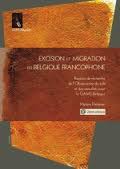|
Read by |
Florine Hinnion, étudiante |
| Genre |
Research report |
|
Target audience |
Scientists, fieldworkers and public authorities |
|
Key words |
Female circumcision, migration, French-speaking Belgium |
DIELEMAN Myriam, Excision et Migration en Belgique francophone: Rapport de recherche de l’Observatoire du sida et des sexualités pour le GAMS Belgique, Bruxelles, Ed. GAMS Belgique, 2010.
About the author
Socio-anthropologist, researcher and director of the Observatory of AIDS and Sexualities.
Topic
The research report of Excision et Migration en Belgique francophone: Rapport de recherche de l’Observatoire du sida et des sexualités pour le GAMS Belgique aims at discerning and evaluating the influence of migration on the practice of female circumcision, in order to understand the reasons why it is being abandoned or carried on within migrant communities from Sub-Saharan Africa.
Le report aims at finding out “what the causes of change related to migration are, and to which extend it fosters the continuation or the abandonment of female circumcision”.
Four main questions stem from that idea:
- Does female circumcision happen in Belgium?
- What are the ends and the meanings of it for the concerned stakeholders?
- What are the resources and obstacles regarding the abandonment of the practice?
- What are the different counter-effects of the measures?
Important to say is that the author states that there have been limits to this research, in such a way than one has to be careful when using and generalizing the results.
Summary
Only a few chapters of the books have been summarized below: chapter IV (Socio- demographic and sanitary prerequisites on MGF), chapter V (Preventing, suppressing and protecting: public action and female genital mutilation), chapter VI (Cases of mutilation in Belgium), and chapter VIII (Changing without continuity: abandoning female circumcision in the context of migration).
In 2008, the WHO (World Health Organization) has estimated that from 100 to 140 millions of women from 15 to 49 years old have undergone female genital mutilation of type 1, 2 or 3 (clitoridectomy, excision and infibulation).
The WHO has counted cases of FGM in 28 Sub-Saharan countries, but also (in a less prominent way) in the Arabic Peninsula and in the Middle East. Cases have also been counted in Latin America and Asia.
In 2008 in Belgium, 22.840 girls and women came from countries were female genital mutilation exists. Amongst them, probably 6.260 women were excised and 1.975 were at risk of being excised. The Walloon region counted 1.978 women and girls who were excised or at risk. The Brussels-Capital Region and the Flemish Region respectively count 3.037 and 3.550 women and girls affected by the issue.
Rumors exist about the presence of women conducting female genital mutilation on the Belgian territory. But the fact that it is taboo doesn’t help one to find evidence of it. It cannot be certified that excision is conducted in Belgium, even if there have been complaints in 2009 and 2010, which never went to court.
But female genital mutilation definitely happens abroad, because of the families sending (or having to send) their daughters to the home country for them to be excised, or when going on vacation. Parents can protect their daughters in different ways: hyper protection (don’t leave your daughter alone with a grandmother, an aunt, etc.), dissimulation (saying that the girl has been excised in Belgium), or using threat (referring to the Belgian law).
As a matter of fact, since the 1st of April 2001, a specific law has been created for the Belgian Penal Code (article 409) which punishes authors of genital mutilation on a female person, with or without her consent. This extraterritorial disposition allows the Belgian justice system to take to court anyone on its territory who has genitally mutilated a minor in another country.
More than its tolerance zero action regarding FGM, Belgium can give the refugee status to asylum seekers in case of risk of mutilation of the woman or the daughter.
Migrants often already start to question the practice of FGM in the home country, but they go deeper in the process of changing their belief when they arrive in the host country. This is explained by the fact that they find out the harmful (medical) consequences of FGM and that it is punishable because it is defined as torture. But the practice remains present in the migrant communities, considering the importance of keeping one’s tradition.
Review
The author establishes a picture of the issue of FGM in the context of migration. She first gives a general insight on the way that the research has been led, and then explores different issues divided up in chapters. Migration is discussed in some of them, but French-speaking Belgium only appears in the 4th chapter. It can be explained by the lack of relevant data that the French Community possesses.
Personal opinion
The author has not been able to give us a lot of information about female circumcision and migration in Belgium, because of the limited amount of available data. It would maybe have been more relevant to study female circumcision throughout Belgium.

